New Telescope to Unlock Mysteries of the Universe
Air Date: Week of April 15, 2022
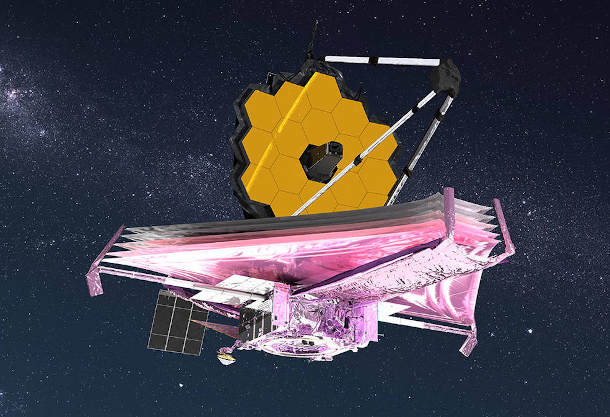
An artist’s rendering of the James Webb Space Telescope, with the multilayered sunshield stretched out beneath the observatory’s honeycomb mirror. (Photo: Adriana Manrique Gutierrez, NASA, Public Domain)
The new James Webb Space Telescope is by far the most powerful space telescope ever built. When the telescope is fully operational, it will be able to see up to a hundred galaxies at once and detect the light emitted from some of the universe's very first stars. It can also look for conditions compatible with life on planets near and far. Dr. Stefanie Milam is the Deputy Project Scientist for Planetary Science for the James Webb Space Telescope, and she joins Host Steve Curwood to explain how the telescope will help advance science.
Transcript
CURWOOD: We all experience gravity anytime we drop an object. But science has yet to explain just how gravity works. Is it a force? Is it a curvature in space time, as Albert Einstein suggested? And along with the mystery of gravity there is also so-called dark matter, which seems to occupy more than 80 per cent of the universe, but we still can’t see it or explain it. Well, two recent amazing developments may help bring some answers. A subatomic particle called the W Boson was discovered back in 1983 but earlier this month scientists reported new measurements of its mass that upend the conventional rules of physics, rules by the way, that have failed to explain gravity and dark matter. Meanwhile on last Christmas Day the massive James Webb Space Telescope was launched into an orbit a million miles above Earth and will start sending back pictures by this summer.
The Webb Telescope can look far deeper into space and further back in time than its predecessor, the Hubble Telescope. Not only will the Webb Telescope see stars born much closer to the so-called Big Bang beginning of our universe, its higher resolution images of super novas and galaxy motion might provide more insight into the phenomena of dark matter and gravity. And because it looks at infrared light it will also help in the search for signs related to life on other planets, both near and far. Here to tell us more about the extraordinary Webb telescope, is Stefanie Milam, the Deputy Project Scientist for Planetary Science at NASA. Stefanie, welcome to Living on Earth!
MILAM: Thank you so much for having me.
CURWOOD: So Stefanie, before we begin talking in detail about this, explain to somebody who really maybe hasn't heard much about this, what kind of telescope we're talking about here.
MILAM: So the space based telescope, the James Webb Space Telescope, is called the successor to the Hubble Space Telescope. So this is NASA's next big astrophysics space telescope that we launched on Christmas Day. And it is going to be looking for the first stars and galaxies across the universe.
CURWOOD: So it's gonna take a look at deep space and way back in time, but also I understand it can look in the local neighborhood at some things.
MILAM: Absolutely. So that was my role on this project actually, was to make sure that not only this extremely sensitive telescope that's studying you know, the farthest reaches of the universe can study first stars and galaxies and planets around other stars, but we can look at things much closer to home. We wanted this to be an all-purpose general observatory that the entire astronomy community could use the way that we've used the Hubble telescope to look at things like Mars or Jupiter or Saturn. But we also study things like distant stars and galaxies and planets around other stars. So we wanted James Webb Space Telescope to offer the same sort of capabilities. And it's extremely hard to look at things in our own neighborhood because they're so bright. And also they move with respect to the other stars, our whole solar system is moving constantly. So being able to track something moving across the sky with respect to background stars, and galaxies, is a whole different capability that a lot of telescopes, especially smaller ones aren't necessarily designed to do.
CURWOOD: The Hubble Telescope still makes remarkable scientific discoveries regularly. I think, just recently, it spotted the most distant star ever detected so far in the universe. So what sets the James Webb Space Telescope apart from the Hubble?
MILAM: So that was an amazing discovery that just happened and a very exciting one. Seeing the farthest star that we've ever been able to observe with the Hubble Space Telescope only motivates and excites the astrophysics community to what the opportunities the James Webb Space Telescope is going to enable. So we have an extremely sensitive telescope, we're 100 times more sensitive than the Hubble Space Telescope at infrared wavelengths. So what the James Webb Space Telescope is actually optimized for is infrared light. So it's like night vision goggles, we're seeing these tiny little faint heat signals across the universe, from when the first stars and galaxies were actually born, right after the Big Bang. So the James Webb Space Telescope is going to look even further back in time than what the Hubble Space Telescope because it's looking at these longer wavelengths of light, because the universe is expanding, and that light is moving away from us, it stretches the light that we would see, for example, with our own sun, or stars in our own galaxy, to longer and longer wavelengths. And so by looking in the infrared with an even more sensitive telescope than the Hubble, we'll be looking at stars that are even older or even further back in time. So, really exploring that sort of infant years of the universe is something that's very exciting, especially for the astrophysics and cosmology communities.
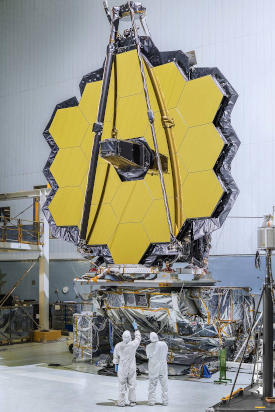
Scientists observe the main mirror assembly of the James Webb Space Telescope in November 2016. (Photo: NASA, Public Domain)
CURWOOD: Stefanie, please give us a brief overview of what your role is on the Webb telescope project. I mean, what were you working on before the launch on Christmas Day? And what are you doing now that the telescope has reached its orbit?
MILAM: So, I've been working on this project for about a decade, they brought me on to make sure that this space telescope can study things in our own solar system. So, things like Mars, asteroids, comets, Pluto, or even things like the rings of Saturn, or tiny little moonlets that are yet to be discovered in the giant planets or the ice giants in the outer solar system. And even if we discover something like the next planet nine, the James Webb Space Telescope is something that would be ideal to use to study those types of objects. And so it was a challenge to bring solar system science into this realm of astrophysics space telescopes, because they're so sensitive, and they're so extremely big and massive that making the move across the sky to track a comet moving or an asteroid flying across the sky is something pretty hard to do. And so it's a whole new capability that we had to make sure that we wanted to have for the James Webb Space Telescope. And so that was my role. And leading up to the launch, it was to make sure that we had one the capability to study things in our own solar system, so tracking moving targets, making sure we could look at extremely bright objects like Mars or Jupiter, and also that we needed to. So making sure that the science was actually something that was of interest to the community. So that was a lot of engagement with the planetary science community but also with the project itself to make sure that the technical capability was there.
[MUSIC: David Bowie, “Space Oddity -1999 Remaster” on Best of Bowie, Parlophone Records Ltd.]
CURWOOD: My guest is NASA scientist Stefanie Milam, and our conversation will continue right after the break. Keep listening to Living on Earth.
Where we’re going, we don’t need roads!
— NASA Goddard (@NASAGoddard) April 14, 2022
To see back in time, @NASAWebb looks in infrared wavelengths, which we feel as heat. @NASAHubble sees visible light, with infrared and ultraviolet abilities. The telescopes will work together as we #UnfoldTheUniversehttps://t.co/Ji53Tq2GQx pic.twitter.com/J5oJZtpCFI
ANNOUNCER: Funding for Living on Earth comes from you, our listeners, and United Technologies, combining a passion for science with engineering to create solutions designed for sustainability in aerospace, building industries, and food refrigeration.
[CUTAWAY MUSIC: Liquid Saloon “Bear Walk” Single, Raw Tapes Records]
BASCOMB: It’s Living on Earth, I’m Bobby Bascomb
CURWOOD: And I’m Steve Curwood, and I’m back now with NASA scientist Stefanie Milam, talking about the new James Webb Space Telescope. Stephanie, thinking about our near space community here, our solar system, how does this ability of the Webb telescope to look at infrared open the door to some interesting discoveries? I mean bbviously you don’t know what you don’t know, but whaddya think you might want to know?
MILAM: We already have some ideas of things that we really want to study with this telescope in our own solar system. So at these wavelengths, we have access to looking for fingerprints of molecules of interest. So every molecule, if you think of your generic chemistry from high school, every molecule has its own fingerprint the same way you have a unique fingerprint with respect to me. And so what we do is we look for these fingerprints of different molecules to study the chemistry of a particular environment. So with the James Webb Space Telescope, we're actually looking at fingerprints of really interesting molecules, when it comes to things like looking for habitable worlds or oceans in our solar system, or just understanding what's actually happening in the extremely different and unique environments, from planet to planet, as well as moon to moon, just as we look across our own solar system. So some of the molecules of interest are things like water, carbon dioxide, methane. These are all molecules that should be ringing a bell of things that are very key signs of life, or even habitability.
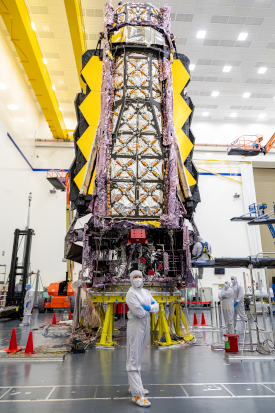
Stefanie Milam, inside the cleanroom where the James Webb Space Telescope resided. (Photo: Courtesy of Stefanie Milam)
And so as we explore our solar system, and we get new spacecraft going to Jupiter, or to Titan, one of the moons of Saturn, or even one of these moons around Jupiter that we think has a subsurface ocean, it's called Europa, we think there's all kinds of extremely interesting environments that could be sustainable for something like life. And so understanding what that chemistry looks like, understanding what the composition of these bodies are, and how that may or may not change is something extremely interesting for planetary science and exploration. And so the James Webb Space Telescope is gonna sort of reveal a lot of these details of these objects in our own solar system that we've never been able to really study with this kind of sensitivity. It helps us provide the right information and level of detail as we send the next generation of planetary explorers out there. So making sure we have the right instrumentation to look for water-like chemistry, or aqueous chemistry. Or if there isn't water there, what is there? Then we can start optimizing our instrumentation so that we're sending the right things there at the right time. This actually applies as we look at other planets around other stars as well. It's the same chemistry that we're gonna be looking at, in these planets called exoplanets, because they're beyond our own solar system. So we're gonna be studying them in the same way that we study the planets in our own solar system. So now we have a comparison that we can actually understand something that's so far away, maybe not quite tangible yet. But we can still get a better understanding of what those planets are made of. And maybe they have an atmosphere, maybe they have volcanoes, maybe they have giant ice oceans. These are the kinds of things that the James Webb Space Telescope gonna help reveal.
CURWOOD: And then you're gonna look to see what exosolar planets, planets around other stars, see how they might match these. And of course, you already have the data for Earth, so you can see if any one of them exactly or closely matches us.
MILAM: Yeah, so the idea is looking for something like an Earth 2.0, is something that, you know, humankind has this innate sense of, you know, discovery that we want to know if there's life out there, if there's another world that we could live on, or you know, travel to at some point. And so searching for something that looks like Earth is of key interest. Plus, it gives us a target for the extremely large number of objects. Now, we're over 5000 exoplanets known today. And so it gives us sort of a short list of objects to start studying, especially when it comes to key questions of things like habitability. So we're not gonna be seeing life itself with the James Webb Space Telescope, we're looking for these key fingerprints of specific molecules that may provoke some sort of unique chemistry happening. And that's some sort of process that's making the chemistry of that planet look different. And that could be because of life. It could be because of geologic processing, so volcanoes, or giant sand storms, or weather, or maybe there's crazy clouds in the atmosphere, like on Venus. These are the kinds of things that we're gonna be studying so that we get a further understanding of these planets, maybe get the list a little bit shorter, even still, with the James Webb Space Telescope, so that the next generation of space telescopes or Explorer missions will be able to study them in even more detail.
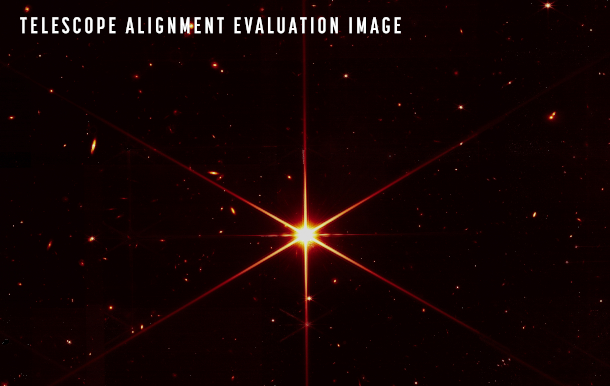
This photo, taken during the alignment process, shows that the James Webb Space Telescope’s optical performance is on track to meet or even exceed the goals it was built to achieve. The image intended to focus on the bright center star, but the sensitivity of the telescope is such that the background galaxies and stars are also visible. (Photo: NASA, STSci, Public Domain)
CURWOOD: So now, what's the timeline for this project? For a moment, let's go back to when it was first conceived, and then tell me how long this mission is expected to last.
MILAM: So going all the way back to the early 90s was when a group of scientists decided that the discovery space that Hubble has opened up was just not quite good enough. And they knew that they were gonna hit a limit. And so this actually came out of an experiment that happened with the Hubble Space Telescope, where they basically stared at a blank piece of sky for a considerable number of hours. And what they found was not blank sky, they actually found thousands of galaxies within something that's the size of your fingernail, if you stuck it up on the sky. Thousands of galaxies, but what happened was, is when they started analyzing the data and seeing how far back in time, they could see, what was the oldest galaxy that we could study with the Hubble Space Telescope, they were blown away about the discovery space that Hubble actually had and the capability that it had. But there was a limit, there was a wall. We couldn't quite push any further. And so to get further, we had to have something much bigger, much more sensitive, and something that actually was optimized for infrared wavelengths. And so that’s sort of how JWST evolved, from, you know, the Hubble Space Telescope to this massive infrared telescope. You know, this beautiful gold mirror, this crazy boat looking structure underneath it to keep it nice and cold, and putting this telescope a million miles away from Earth so that it could stay cold and operate. Putting it that far away, unfortunately means that we do have a limited life mission, because we can't send astronauts there currently, to go and service the telescope the way, that we've serviced the Hubble Space Telescope for decades. So what that means is we had to carry a certain amount of fuel to operate the telescope, to do things like offset momentum, to make sure we stay in the right place in its orbit. And also just to control the telescope. Fortunately, we had a very beautiful launch with Arianespace, we were on a rocket that launched out of French Guiana that was provided by the European Space Agency. It sent us on a beautiful trajectory, a million miles away from Earth. And we were actually able to conserve a lot of fuel, which means that our mission lifetime went from a ten-year that we were projecting at launch to something that looks more like 20 years of operations now.
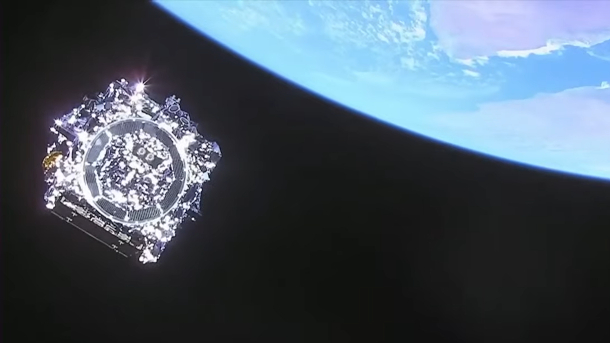
The James Webb Space Telescope, seen shortly after separation, as photographed from the upper stage of the Ariane 5 rocket. (Photo: NASA, Public Domain)
CURWOOD: So there have been some calibration and alignment photos from the James Webb Space Telescope already. But when are we gonna start to see the first scientific photos, both the stuff that you care about nearby and the deep space stuff?
MILAM: Well, I will honestly tell you that all of the calibration images we've seen so far has been absolutely amazing and astonishing for me and the whole project. And every single day, we get to see more and more of these. And it's all the more impressive of how well this observatory actually works and really exciting to think about what it's going to do for us. But the first science images are actually going to be released in the summer. So late June to mid July, that time is still to be determined depending on how well commissioning goes. They'll all be released at once. There'll be some probably NASA event going on. And some online, you know, you can log in and follow along with us. But as soon as that happens, it's basically the initiation of science operations for the James Webb Space Telescope. So we already have our first year of science observations already planned. It includes everything from solar system observations, deep studies of the distant universe, studying planets around other stars, watching planets and stars being formed in their own stellar nurseries in our galaxy and in the universe, how galaxies merge together, how they evolve, how stars evolve, what happens when they die, all kinds of really amazing science, that I don't know if there's a way to prioritize it as far as enthusiasm. But I think it's all gonna to be exciting, and we're gonna rewrite the textbooks.
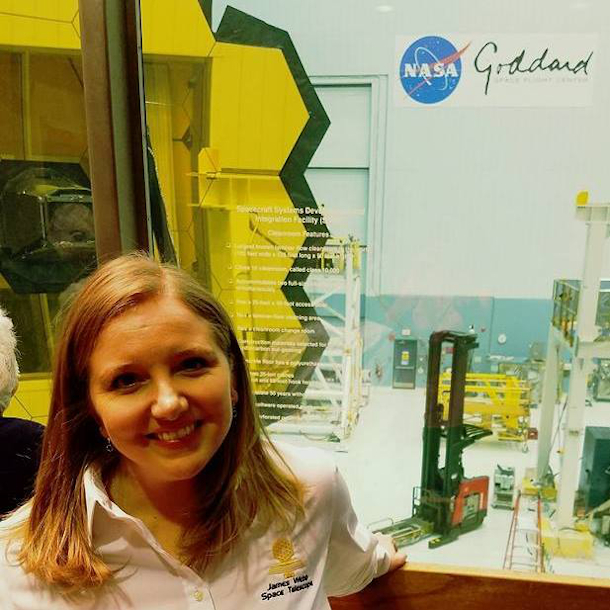
Stefanie Milam, outside the cleanroom where the James Webb Space Telescope resided. (Photo: Courtesy of Stefanie Milam)
CURWOOD: Stefanie, what are you personally most excited to study with the data we're gonna be getting from the James Webb Space Telescope?
MILAM: Well, so I'm a cometary scientist. So I study comets in our solar system. And I also study interstellar objects, which are new things that we've discovered in our solar system. So these are comets or asteroids that come from other planetary systems. So what we learned from comets is basically, how the solar system actually formed. What was the process? What was the chemistry like? How did something like Earth, with liquid water on its surface, all the right ingredients to have biology, biochemistry, how did that all get here in the right place? The right time, the right composition? What were those ingredients? And if those ingredients are something that are ubiquitous across our whole galaxy or other planetary systems, then that's something that will give us key insights into what kind of planets, what kind of planetary systems, or even what kind of star forming systems or regions we need to be looking for in our search for this Earth 2.0. So comets are basically, you know, the relics or fossils of when our solar system formed. So by studying them, we learn a lot about all of those key ingredients, all of the processing that happened during the formation of the solar system. And so the James Webb Space Telescope is actually very accessible to studying these objects.
CURWOOD: But wait, you said that there are some comets from other solar systems? What about that? How the heck did they get here? And what do they tell us?
MILAM: Yeah, so we now have discovered two interstellar objects. One of them looked like an asteroid or a spaceship to some people. It was called ʻOumuamua. And the second one actually looked like a comet, and it was called Borisov. We expect with all the new surveying telescopes that are coming online, such as the Rubin Observatory down in South America, as well as a number of other large surveying capabilities that are being built and getting ready to be operational, we're gonns to discover more and more of these kinds of objects. So these are basically the the comets or asteroids that whenever another planetary system is forming, maybe they collided with another one. And it bumped it off course, such that it got ejected from its own planetary system. We've anticipated and expected this is something that happens with our own small bodies in our solar system. But I don't know that anyone ever really anticipated that we'd actually discover one from another planetary system in our own solar system. So it was extremely exciting for this discovery to actually happen a few years ago.
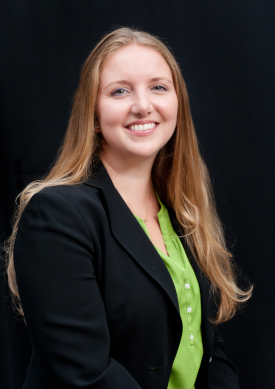
Stefanie Milam is NASA’s Deputy Project Scientist for Planetary Science for the James Webb Space Telescope. (Photo: Courtesy of Stefanie Milam)
And now that we found two, that are completely different from one another, your imagination goes wild. What does this mean? What is this telling us about one, not only the planetary system that they formed in, but what does it tell us about the journey that that object had to have going from its planetary system through space, and the harsh conditions of radiation from nearby supernova, or stars colliding with each other, or new planetary systems forming or whatever, all the way on its journey to get to our own planetary system. So there's all kinds of things that are really interesting about these objects. We're so excited for the next discovery of one, and all hands are on deck to observe it with every every telescope on Earth and in space.
CURWOOD: If you discover it, is it gonna be called the Milam Comet?
MILAM: Yes.
CURWOOD: Woah!
MILAM: Well, so far, comets are named after their discoverers. And so far, interstellar objects are named for their discoverers. So we'll see.
CURWOOD: You haven't discovered one yet, but...
MILAM: I haven't discovered one yet. But I will say asteroids also get designated name. And so I do have an asteroid named after me.
CURWOOD: Oh, and that one is called?
MILAM: Milam.
CURWOOD: How big is Milam?
MILAM: It's small. I think it's about 10 meters is what they're predicting.
CURWOOD: So about 30 feet wide.
MILAM: Yeah, not very big. It's in the main belt. It's, it's a rock. But it's my rock. So it's a really cool rock.
CURWOOD: Stefanie Milam is the Deputy Project Scientist for Planetary Science for the James Webb Space Telescope. Thanks so much for taking the time with us today.
MILAM: Thank you so much for having me. This was a lot of fun.
Links
Scientific American The James Webb Space Telescope Could Solve One of Cosmology’s Deepest Mysteries
Read more on the James Webb Space Telescope at the official NASA site
Stefanie Milam’s biography page
Living on Earth wants to hear from you!
Living on Earth
62 Calef Highway, Suite 212
Lee, NH 03861
Telephone: 617-287-4121
E-mail: comments@loe.org
Newsletter [Click here]
Donate to Living on Earth!
Living on Earth is an independent media program and relies entirely on contributions from listeners and institutions supporting public service. Please donate now to preserve an independent environmental voice.
NewsletterLiving on Earth offers a weekly delivery of the show's rundown to your mailbox. Sign up for our newsletter today!
 Sailors For The Sea: Be the change you want to sea.
Sailors For The Sea: Be the change you want to sea.
 The Grantham Foundation for the Protection of the Environment: Committed to protecting and improving the health of the global environment.
The Grantham Foundation for the Protection of the Environment: Committed to protecting and improving the health of the global environment.
 Contribute to Living on Earth and receive, as our gift to you, an archival print of one of Mark Seth Lender's extraordinary wildlife photographs. Follow the link to see Mark's current collection of photographs.
Contribute to Living on Earth and receive, as our gift to you, an archival print of one of Mark Seth Lender's extraordinary wildlife photographs. Follow the link to see Mark's current collection of photographs.
 Buy a signed copy of Mark Seth Lender's book Smeagull the Seagull & support Living on Earth
Buy a signed copy of Mark Seth Lender's book Smeagull the Seagull & support Living on Earth

